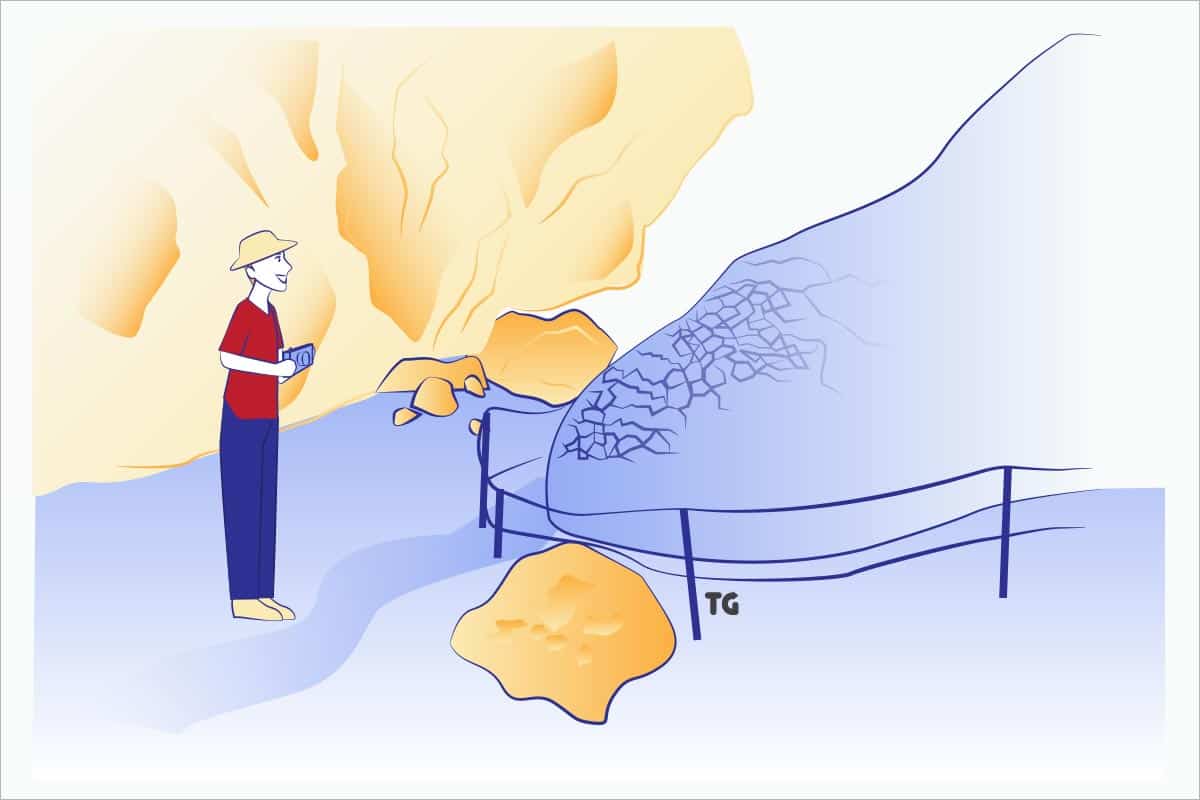Thailand is one of the most visited destinations attracting millions of people worldwide every year. Blessed with beautiful beaches in the southern and eastern regions and old temples and heritage buildings in the central and northern parts, Thailand is a country that has something for everyone.
One of the least visited areas of Thailand is the Northeast. This region is not universally popular among international tourists, yet it is blessed with abundant historical and cultural heritage and traditions. Especially the most outstanding and collective symbol of all the cultures is “Phrayanak” or “Naga.”
The powerful myth of the Naga is felt everywhere and has deeply influenced aspects of Thai traditions. Whether it is from myths, legend (both from Buddhist stories and indigenous stories), beliefs, literature, oral history, weather forecast, way of life, festivals such as Boon Bang Fai (Rocket festival or Naga fireballs), rituals of the people within the Mekong region, sculpture, or in architecture, such as the Naga in Buddhist architecture as an auspicious symbol (the guardian of the temples). (1, 2)
Unfortunately, these are still not enough to attract tourists, unless they are true cultural tourism fanatics. However, the recent discovery of the Naka Cave has turned the Northeastern region of Thailand into one of the most popular destinations for many local tourists. Thousands of Thai people visit this place for a day during the new year. Whatsmore, it is an attraction growing in notoriety among foreigners.
Where Is Naka Cave in Thailand?
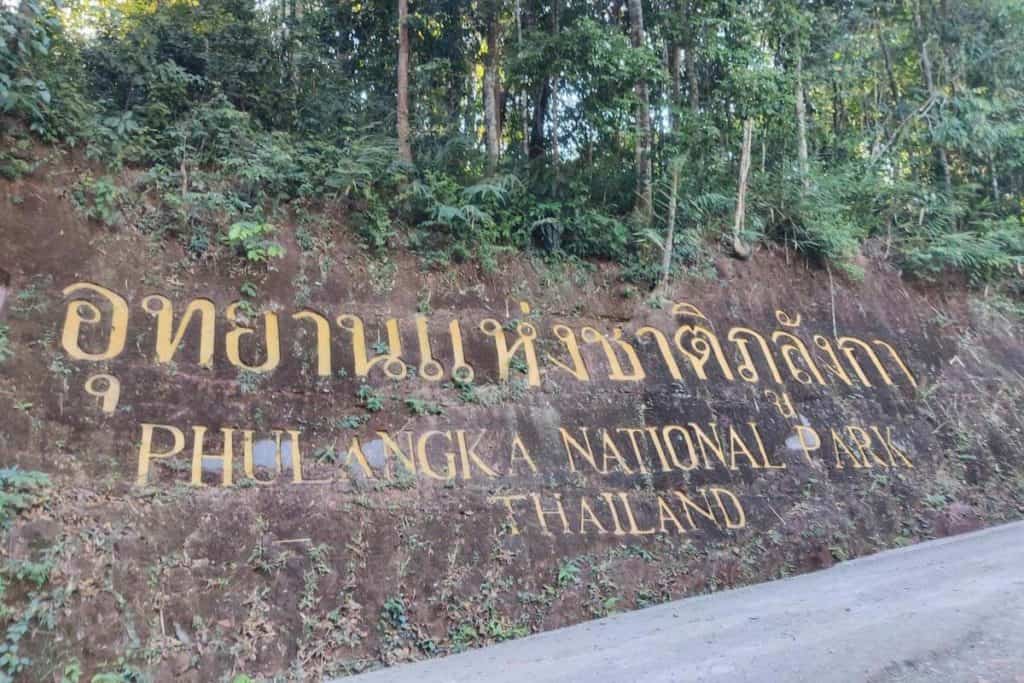
Naka Cave (ถ้ำนาคา) or Phaya Naga Cave (ถ้ำพญานาคา) lies within the boundaries of the Phu Langka National Park (อุทยานแห่งชาติภูลังกา) in the area of Bueng Kan Province. The National Park is the boundary between Bueng Kan Province and Nakhon Phanom Province (Northeast Thailand).
The area consists of three overlapping mountains with small mountain ranges spreading along the Mekong River. Its lush forests provide habitats for a mass of wildlife and watershed for many streams. (3)
Highlight of Naka Cave:
The highlight of Naka Cave is that there are many rocks and cave walls shaped like a giant snake (or the body of a serpent) curled up with important parts (including the head, body, and scales of the serpent) according to the imagination and beliefs of the local people. It is believed that worshiping the Naka Cave Snakes will enhance prestige, fortune, and wealth. (4)
Inside the cave, glossy white cavern walls are covered with minerals and patterned like snake scales. Therefore, some people believe that it is a giant petrified snake. Because of this, the cave is named after the legend of Naka, which is a mythical serpent in Thai folklore, as well as other Southeast Asian and South Asian cultures. Also, there are many paintings and decorations inside, one of which depicts Thai monks in a traditional ceremonial costume with tigers.
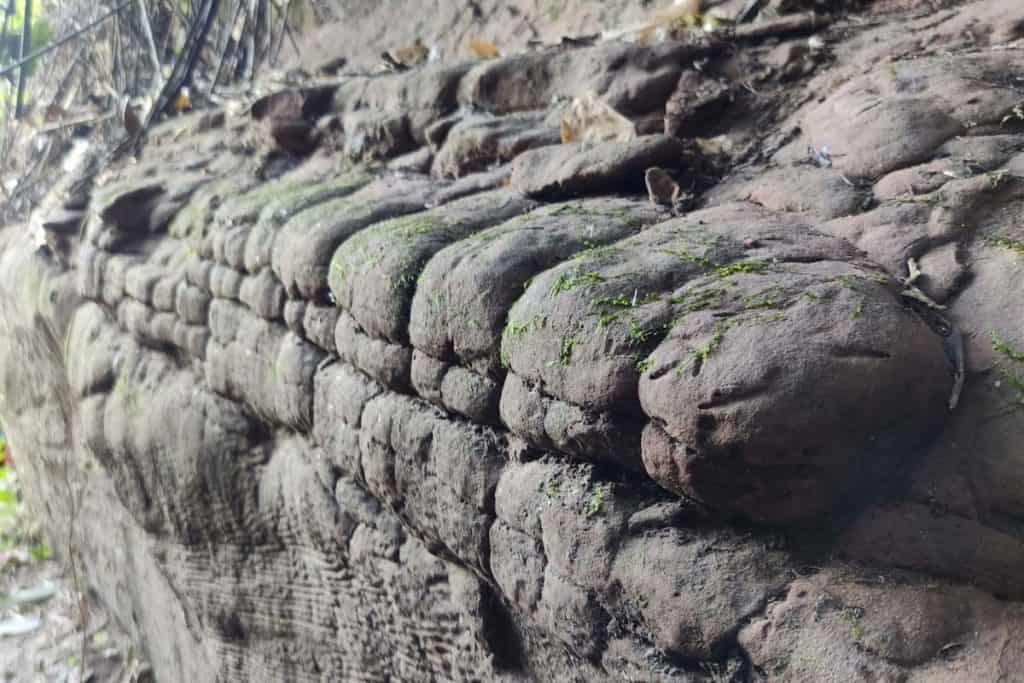
Interestingly, the Naka Cave and its extraordinary rocks shaped like serpents are not the only attraction, but also many incredible things around the area of the Phu Langka National Park, such as:
- The 2 kilometers hiking trail leads to the peak of the mountain where you can see breathtaking views of the town and the Mekong River.
- Along the way, you can enjoy waterfalls nearby such as Tat Wimanthip Waterfall and Wat Tham Chaimongkol.
- There are also Buddhism places where you can pay homage and make a wish such as Luang Pu Wang Cave, Chedi Luang Pu Wang, and Chedi Luang Pu Sao.
How to Trek to Naka Cave:
To get to the Naka Cave, you start at the Wat Tham Chaimongkol, then climb up a stone staircase decorated with Nakas, some steel staircase, and gravel paths. The trek to the Naka Cave is around 2.5 kilometers (4 – 5 hours for a round trip).
Therefore, you should start trekking in the early morning because there are many points to visit, and the National Park has scheduled to descend from the mountain before 17.00 (overnight or camping is not allowed). (5)
Other Snake Caves in Thailand
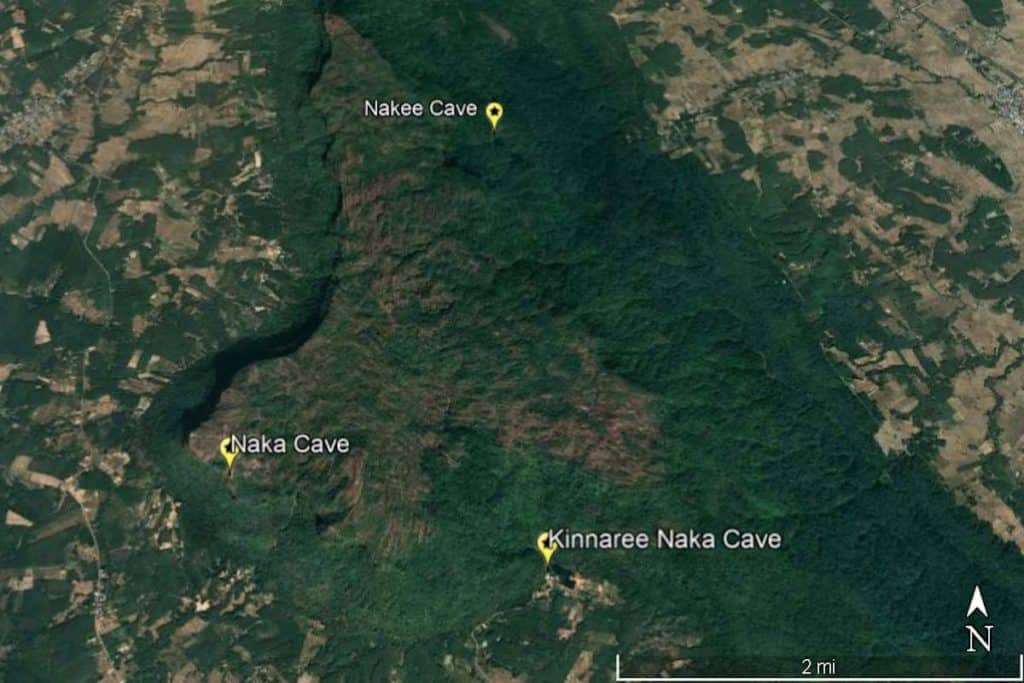
Remarkably, Naka Cave is not the only place with snake-shaped rocks in the Phu Langka National Park. Two other sites were also recently discovered at the same time – Nakee Cave and Kinnaree Naka Cave. But, they are not as famous as the Naka Cave.
Naka Cave, Nakee Cave, and Kinnaree Naka Cave (source: Google Earth 2022)
Nakee Cave:
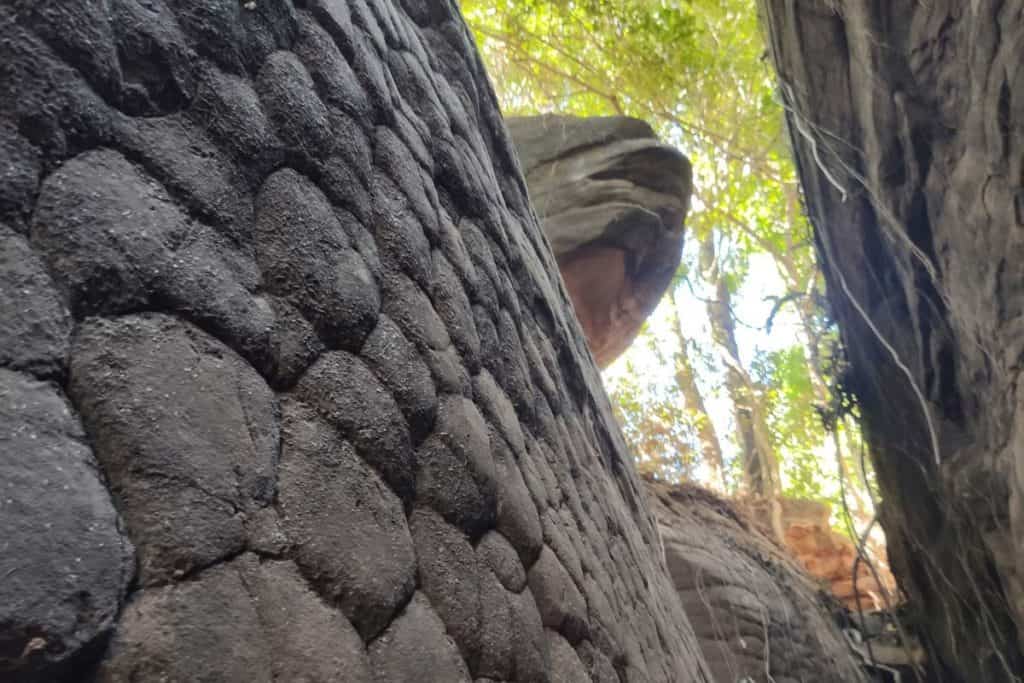
Nakee Cave (ถ้ำนาคี) is on the opposite side of the Naka Cave in the east (approx. 5 kilometers), which is in the area of Phu Lanka National Park, Nakhon Phanom Province. The name “Nakee” is given in accordance with the Naka Cave. This cave is another important nature trail and resembles the scales of the giant snakes similar to those found in the Naka Cave.
To reach this cave, you can start from the Phu Langka National Park entrance, a total distance of 2.5 kilometers (4 – 5 hours for a round trip). However, you can also reach the Nakee Cave by trekking along mountain paths from the Naka Cave – but this is not a recommendation unless you have the National Park officials or local guides with you. (6, 7)
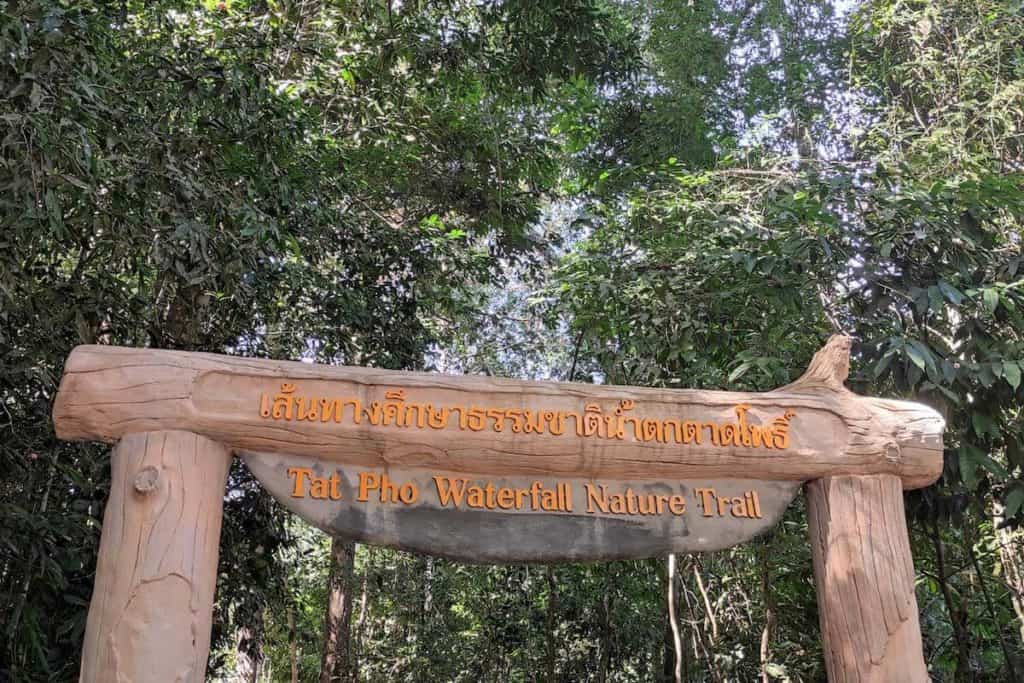
On the way to the snake cave, you will study nature – there are labels describing the importance of forest resources, watersheds, and the names of plants and animals along the way. Moreover, you can also stop at some fantastic viewpoints such as Pha Ngoi Waterfall, Sai Ngam Waterfall, Pha Sawan Waterfall, Tat Pho Waterfall, Pha Hua Rot Bus (a cliff that looks like a bus head), Pha Jai Kad (a scary cliff).
Walking for about half a kilometer from the Nakee Cave, there is a spot for a beautiful viewpoint of the Mekong River called “Pha Nakee (Nakee Cliff).” When you walk back to the starting point at the National Park, you will see another route nearby the entrance, about 4 kilometers. If you go along this way, you will reach the Sibunnao Kong Khao Pagoda – this is where camping is allowed. (8)
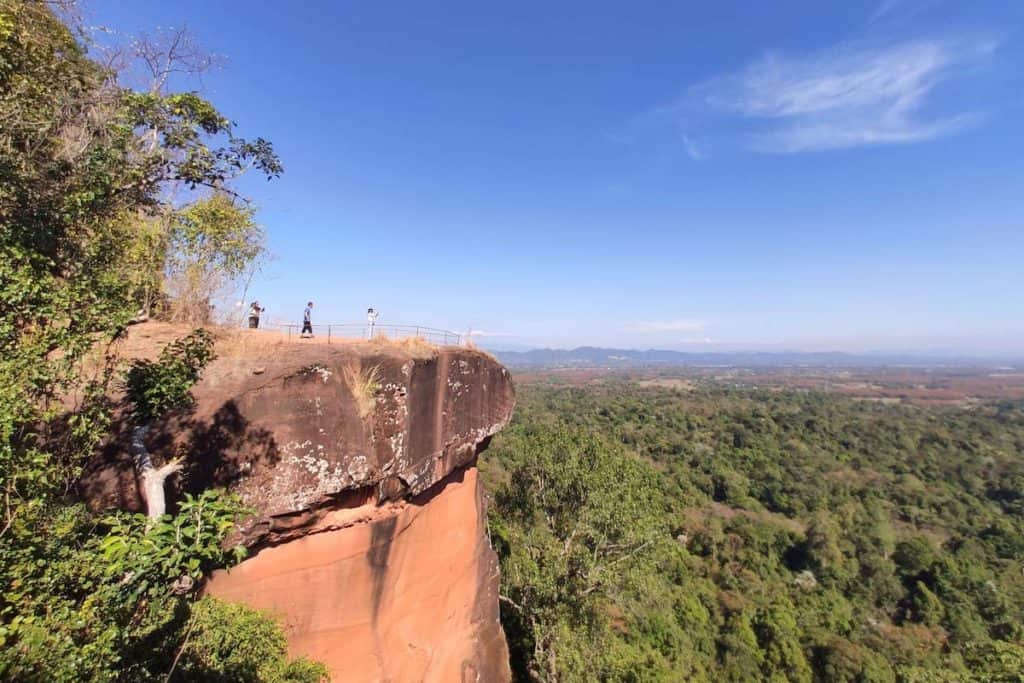
Kinnaree Naka Cave:
Kinnaree Naka Cave (ถ้ำกินรีนาคา) is one of the nature trails in the Phu Langka National Park, Bueng Kan Province. This cave resembles the scales of the large snakes similar to those found in the Naka Cave and the Nakee Cave, but the distance from the entrance of Wat Pa Kinnaree to reach the cave is not very far, about 100 meters.
It is a new tourist attraction that is not very well known compared to the two caves but is equally extraordinary. The name “Kinaree Naka” comes from the name of Wat Pa Kinnaree and combines with the word “Naka” to correspond to the Naka Cave Thailand.
In the vicinity of Kinnaree Naka Cave, around 1 kilometer, two rock groups have recently been discovered, namely “Hin Naka Ong Daeng” (หินนาคาองค์แดง: the red Naka rock) and “Hin Naka Ong Dam” (หินนาคาองค์ดำ: the black Naka rock).
These two rock groups are rocks shaped like a snake as well. In addition, you can admire the nature of Kinnaree Waterfall, Tat Kham Waterfall, and Hin Loma (หินโลมา: Dolphin Rock), which are intricate rock formations shaped like dolphin heads. (9, 10)
Phu Langka National Park, Thailand (Taken on January 2022)
How To Get To The Giant Snake Rocks from Bangkok
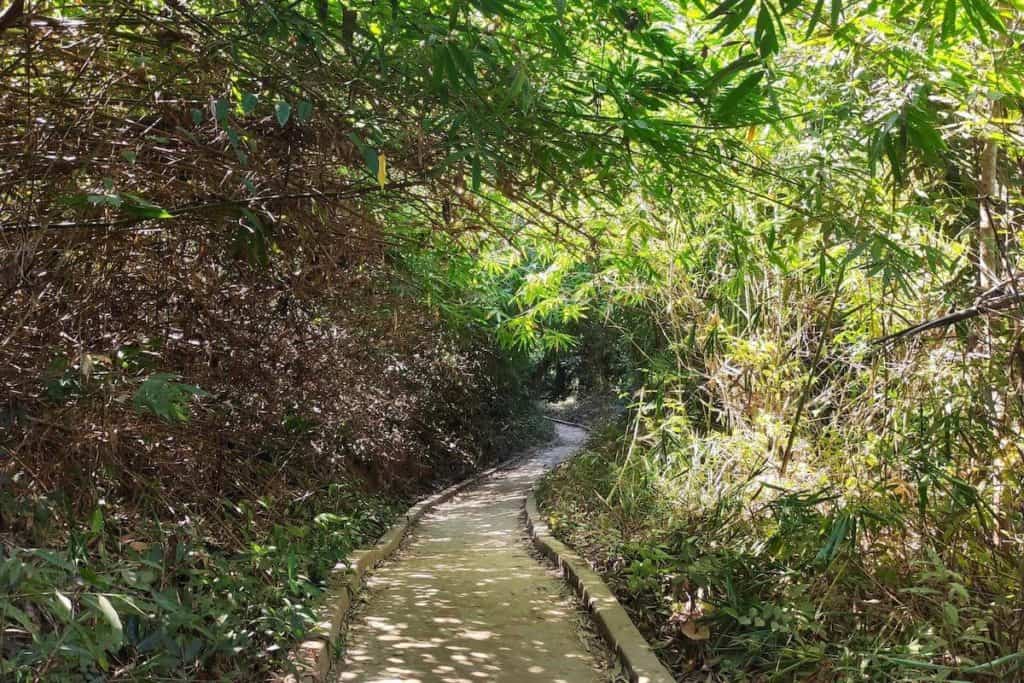
The giant snake rocks are located in the Phu Langka National Park, in the most remote area of Northeast Thailand. Traveling to this area is not that easy – it is better to have a private car; however, it is worth visiting! If you start from Bangkok, the best ways to reach these places are as follows: (1, 11)
- Take a plane to Udon Thani Province (1.5 hours), rent a car, and drive to the Phu Langka National Park, 197 kilometers (3 – 4 hours). It takes about 5 – 6 hours in total;
- Take a plane to Nakhon Phanom Province (1.5 hours), rent a car, and drive to the Phu Langka National Park, 120 kilometers (1 – 2 hours). It takes about 3 – 4 hours in total;
- Take a bus to Bueng Kan Province (12 hours), rent a car, and drive to the Phu Langka National Park (1 hour). It takes about 13 hours in total;
- Take a train to Nong Khai Province (9 hours), rent a car, and drive to the Phu Langka National Park (3 hours). It takes about 12 hours in total;
- Drive a private car to the Phu Langka National Park. It takes about 10 – 11 hours in total.
The recommended season to visit these places are between May and October, when lush greenery can be seen everywhere on Phu Langka Mountain. The best time to visit is early morning to enjoy the stunning view of sunrise.
Besides viewing the giant snake rocks, if you desire to go up to the top of Phu Langka Mountain and camping, make sure to contact the Phu Langka National Park 7 days in advance. They provide areas for camping and tents for rent.
Phu Langka National Park Information:
| Opening Hours | Naka Cave: Every day, 08.00 – 14.00 Nakee Cave: Every day, 08.00 – 16.00 Kinnaree Naka Cave: Every day, 08.00 – 16.00 |
| Admission Fee | Thai national: Adult 30 THB (fee 20 THB and life insurance 10 THB), Children 20 THB (fee 10 THB and life insurance 10 THB), Deposit 100 THB /group Foreigner: Adult 200 THB, Children 100 THB **To visit the Naka Cave, tourists must book tickets in advance (no more than 15 days, the number of tourists for visiting the Naka Cave Snake is limited per day) through a mobile application called “QueQ” only. No reservations are required for the Nakee Cave and Kinnaree Naka Cave. |
| Location | Naka Cave: ↪Google Map Nakee Cave: ↪Google Map Kinnaree Naka Cave: ↪Google Map |
| Contract | 084-792-3505 or 042-530-766 |
| Website | https://www.dnp.go.th/ |
Things To Keep In Mind Before Visiting Naka Cave
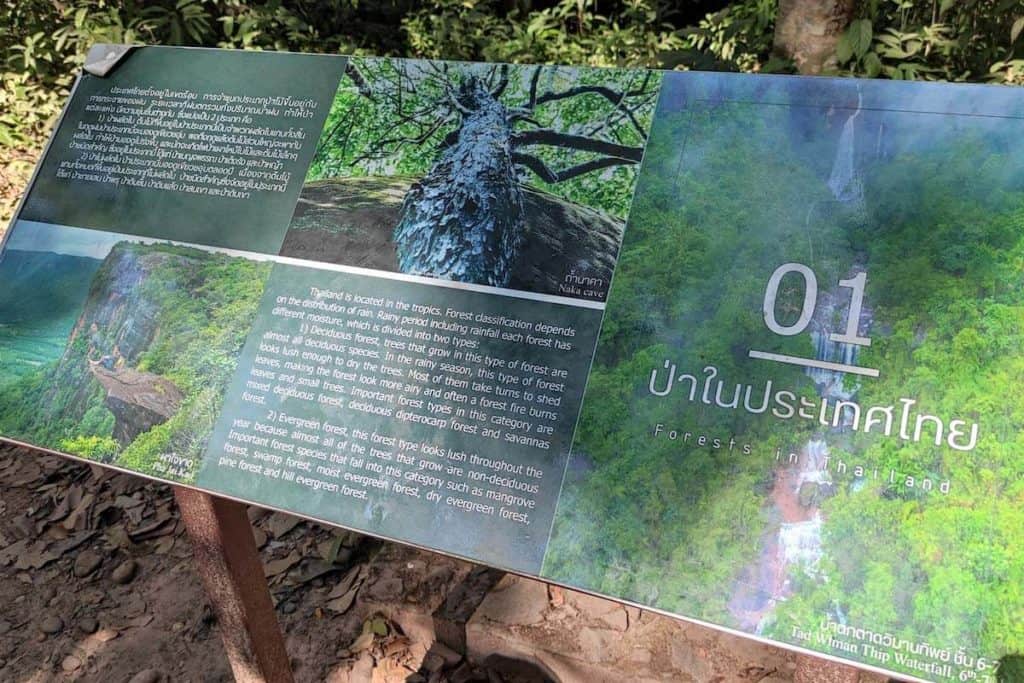
When planning your trip to the snake cave in Thailand, the most important thing is to prepare your body as it is a steep path and the distance is quite far. Here is the advice: (11)
Preparation before visiting the Naka Cave Snake:
- Dress up and wear sneakers suitable for trekking;
- Prepare drinking water or personal items that are necessary;
- Not recommended for people who are physically weak, especially patients with high blood pressure, diabetes, heart disease, or arthritis;
- Not recommended for pregnant women, people who are overweight (more than 100 kilograms), and children under 7 years old.
Etiquette when visiting the Naka Cave Thailand:
- Be respectful as it is a sacred place according to the beliefs;
- Do not touch the sculptures in the cave such as stalagmites, stalactites, pillars, etc.;
- Do not smoke, make bonfires, light incense sticks, or do any other activities causing the changes in the weather inside the caves;
- Do not bring food into the caves and dispose of any rubbish (tissue paper, drinking straws, plastic bags, foam boxes, flowers, incense sticks, and candles or offerings are strictly prohibited);
- Do not make noise that disturbs the animals, including the prohibition of shooting guns, firecrackers, and explosives;
- Do not bring pets or vehicles into the caves;
- Do not write, scratch, erase, smear, paint, spray, or post any notice;
- Do not defecate or urinate in the caves;
- Do not collect anything out of the caves such as stones, mineral seals, fossils, artifacts, or living things inside the caves;
- Do not take any action that changes or damages the water paths;
- Do not camp in the caves;
- Do not walk outside the specified paths.
Who Made The Naka Cave Thailand? (The Legend, Myth, Folklore)
According to the famous myth, it is believed that the Mekong River in the Northeast of Thailand was created by two Naga kings slithering through the area. The wonders of the Naka Caves (the rock caves shaped like the large snake) in the Phu Langka National Park near the Mekong River are believed to be made by Naga too.
What Does “Naka” Mean?
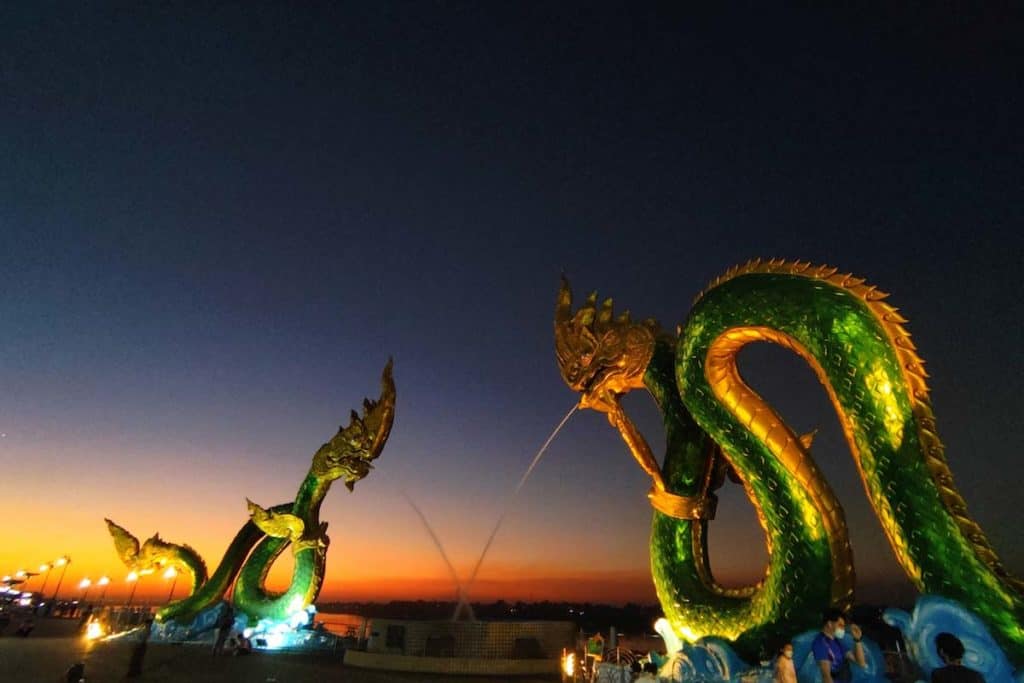
“Naka” or “Naga” is the sacred name of the mythical serpent in Thailand, some parts of Southeast Asia, and India. The word “Naka (Nāga)” comes from Sanskrit (Hinduism) and various dialects, causing a change in the pronunciation of “Nāga.”
For example, the pronunciations Ngan, Ngua, Nam Ngu Ak-Ngu, and Namngum are found in Thailand and Laos. It refers to the serpent creatures or snake deities associated with water. The term Nāga is the male form of the serpent, while Nakee (Nagi) is the female name or the name of the goddess, both in human and serpent forms.
Nāgas and Nagis have various images such as the water Naga in Ahom culture, the crocodile in Shan culture, the water snake in White Tai culture, the dragon in Payi culture, and the serpent in Thai culture.
Therefore, the names, pronunciations, and images of Nāgas and Nagis vary from area to area. (12, 13) For “Kinnaree Naka,” it basically comes from two words, “Kinnaree” is one of the most famous Thai mythological creatures with half–female and half-bird forms, while the word “Naka” refers to the serpent creatures. (14)
The Naga is widely disseminated in Indian and Southeast Asian folklore, religion, and architecture. In Thailand and Laos, the Naga is presently more commonly known as Phrayanak. The word “Phraya” means king or royalty, and “Nak” means Naga; therefore, Phrayanak is the King of the Nagas. (15)
What is the Story Behind Naka Cave and the Cursed Stone Snake?
In Thailand, the Naka Cave and other snake caves have 7 myths or folktales (a traditional story closely related to religion) associated with them. These being:
- The myth of the Naga that was cursed to stone.
- The myth of Phaya Nakarat (underwater city).
- The myth of the city of Bangbod people called “Lap Lae City (hidden city).”
- The myth of the birth of 5 Buddhas.
- The myth of passion battlefield (Phra Thu Dong Kam Than).
- The myth of the paranormal, sacred, and herb land.
- The myth of the Ramayana.
The myth of the Naga that was cursed to stone:
The myth of the Naga is one of the most familiar myths, which is about the serpent being cursed to stone from “the story of Pu Aue Lue” related to the area of Phu Lanka (mountain) and Bueng Khong Long (swamp). (11)
According to the myth or folklore of Pu Aue Lue, it is believed that it began with the impossible love between the Naga and the human, and it caused the destruction of the city of Rattana Nakhon, ruled by Phra Lue Racha.
Phra Lue Racha had a grandson named Prince Fah Rung, who married Princess Nakrinthranee, a daughter of Phraya Naga Racha of the underwater city, who transformed into a human form. The two lived together but were unable to have any descendants.
Later, Princess Nakrintrani was sick, causing her body to become a nagi. The two lived together but were unable to have any descendants. Phra Lue Racha and the people of Rattana Nakhon were dissatisfied then ousted her to the underwater city.
Phraya Nagarat was very angry and destroyed the city. While Phra Lue Racha was caught and cursed to become a stone snake trapped in the cave to guard Phu Lanka or Mekong River forever. (16, 17)
The myth of Phaya Nakarat (underwater city):
Another well-known story is “the myth of Phaya Nakarat (underwater city)” from Luang Pu Wang. Luang Pu Wang said that the Naga came to see him in a vision and asked for merit. Then next day, at noon, a red snake, about 0.5 meters in length, slithered into the Chaimongkol Cave (Wat Tham Chaimongkol near the Naga Cave) and disappeared.
The next morning, Luang Pu Wang said that the Naga had come to tell him that he had already received merit and would like to say goodbye before going to a better world. Luang Pu Wang also said that the Naga is a noble and sacred animal living in the underwater city in the area of Phu Langka, Bueng Khong Long, Si Songkhram River, and other rivers.
The red Nagas, especially red-necked Nagas, are friendly with the monks who preserve Buddhism and the Dharma – If the monks do not follow, the Nagas will not protect and curse them. (16, 17)
The other 5 myths:
The other 5 myths that are not mentioned here are stories of the sanctity of the Phu Langka Mountain, which is not related to the Naga in any way. However, if listening to the Naga myth from elderly people or even people living in different areas, the content and details are sometimes different. Over time, the myths’ content, meanings, and symbols have changed in this region.
However, these narratives can also reflect the people’s livelihood within the society. When you learn about it, you can gain a deeper understanding of the people in the local area, culture, social norms, and the morality structure between people.
Is the Naka Cave a Real (Fossilized)Snake?
Because the rocks are shaped like the scale of a giant snake, no wonder why local people believe it is related to “the Naga myth,” and some believe that it is actually the frozen remains of an ancient serpent in folklore. However, it is not a real snake nor a fossilized snake.
Considering that the biggest and heaviest snake in the world ever recorded was 8.43 meters in length with a girth of 1.11 meters. (18) Therefore, the rocks in these caves cannot be a giant petrified snake.
While some are of the opinion that humans created these rocks, the rocks shaped like snake scales may be carved in patterns by humans in accordance with the legend of the Naga. However, if considering the pattern carefully, this is not something that humans made.
What Geology Suggests:
Interestingly, these doubts have already been proven by geological science. The geologists explain in terms of geology that rocks were formed by two types of weathering processes: (19)
- Thermal expansion: it was formed by rocks on the Earth’s surface through alternating hot – cold temperature changes continuously, causing rocks to expand (with heat from the sun during the day) and contract (with cold at night). When this happens over and over again, the structure of the rock weakens and eventually crumbles into small pieces. The cracks on the surface surrounding the rock sometimes are called “Sun Crack.”
- Alternate wetting and drying: it is the decay caused by the alternating absorption and evaporation of water in the rocks, causing rocks to expand and contract. This mainly occurs in sedimentary rocks with small grains and clay minerals.
Therefore, the giant snake rock was formed from sun-cracked rocks, the change in temperature, and water erosion.
This natural occurrence can also be seen in the Phu Hin Rong Kla National Park (อุทยานแห่งชาติภูหินร่องกล้า), the protected area located in Loei and Phitsanulok Provinces (20, 21) and Phu Sing (ภูสิงห์) or known as Hin Sam Wan (หินสามวาฬ), a part of the Kala Rainforest National Reserved Forest located in Bueng Kan Province. (22)
However, when you visit these places and have the opportunity to have a conversation with a local guide, local people, or even those who have a strong belief that this is a real giant snake related to the Naga myth, you should carefully consider if you should explain this geological fact or not – faith is a fragile thing!
Other “Naga” Caves in Thailand
Interestingly, besides the Naka Cave and another two caves nearby, due to the strong belief of the Naga in Thailand, there are many snake caves related to the Naga. The caves are divided into two categories: natural and man-made. (23, 24, 25)
Natural Caves:
Wat Tham Si Mongkhol (วัดถ้ำศรีมงคล) or Tham Din Pieng (ถ้ำดินเพียง)
Open Hours: Every day, 09.00 – 17.00. Location: ↪Google Map
Wat Tham Si Mongkhol is located in Pha Tang Subdistrict, Nong Khai Province. It is a beautiful stalactite and stalagmite cave, one of the Unseen attractions of Thailand. With the appearance of the cave with a channel that connects to each other and has water flowing all year round. This led to the belief that this is a Naga cave.
Tham Luang Khun Nam Nang Non (ถ้ำหลวง ขุนน้ำนางนอน)
Open Hours: Every day, 08.00 – 17.00. Location: ↪Google Map
Tham Luang Khun Nam Nang Non is located in the Doi Nang Non-National Reserved Forest, Chiang Rai Province. It is the 4th longest limestone cave in Thailand. This cave has many myths, including the myth of the princess of Chiang Rung and the myth of the Princess of Bagan. Also, the myth of the Naga, which is believed that the Naga looked for his daughter, who was kidnapped by Garuda and finally found her in the area of this cave.
There is also a small cave under a mountain cliff that is believed to be a place of meditation, and the highlight of this cave is its large stalagmites resembling a hood of the large snake.
Kaeng Ahong (แก่งอาฮง)
Location: ↪Google Map
Kaeng Ahong is the deepest islet of the Mekong River, about 200 meters, known as the Navel of the Mekong River, located in Bueng Kan Province. Under this islet, there is a large cave connecting Laos, Phu Ngu, and Kham Chanot, which is believed to be the Naga Palace. This area is also another spot to watch the Naga fireballs during the end of Buddhist Lent.
Wat Tham Dao Khao Kaew (วัดถ้ำดาวเขาแก้ว)
Location: ↪Google Map
Wat Tham Dao Khao Kaew is located not far from Big Tae Park, the famous flower garden in Saraburi Province. This cave is not a well-known attraction for tourists but very famous for Buddhists who believe in the Naga because it is believed to be a sacred cave inhabited by the Nagas.
Wat Tham Nam (วัดถ้ำน้ำ)
Location: ↪Google Map
Wat Tham Nam is located in Ratchaburi Province. Inside the cave, there is water flowing all year round, large stalactites and stalagmites in the middle of the cave, and a cement walkway to view the cave’s beauty. Walking through this cave is like walking through the underwater city of the Nagas. Along the way, there are also Buddha images and sacred things to pay respects to.
Phaya Nakarat Cave (ถ้ำพญานาคราช)
Location: ↪Google Map
Phaya Nakarat Cave is a spectacular natural cave. Inside the cave, a large stone pillar separated the cave into several chambers, thin limestone fluttering as beautiful as a curtain and glittering floors and walls like a diamond that shines very beautifully. It is believed to be the Naga Palace. (26)
Man–Made Caves:
Phayanak Cave (ถ้ำพญานาค)
Open Hours: Every day, 07.00 – 16.00. Location: ↪Google Map
Phayanak Cave is a part of the Wat Thai where is the most famous viewing point for Naga fireballs in Nong Khai Province. This cave is a replica of the underwater city of the Nagas that was built in 2007.
Nakathibodi Cave (ถ้ำนาคาธิบดี)
Open Hours: Every day, 09.00 – 17.00. Location: ↪Google Map
Nakathibodi Cave is in Wat Pa Si Mongkhon Rattanaram, a place for practicing meditation and tourist attractions in Sisaket Province. This cave is a replica of the Naga palaces with stalactites and stalagmites. Inside the caves, there are white jade Buddha and Naga statues.
Rattana Mani Maha Nakhon Badan Nakarat Palace (วังรัตนมณีมหานครบาดาลนาคราช)
Open Hours: Every day, 07.00 – 18.00. Location: ↪Google Map
Rattana Mani Maha Nakhon Badan Nakarat Palace is a part of Wat Maniwong, an over 100-year-old temple in Nakhon Nayok Province. This beautiful replica cave was built to serve as a place of meditation. The cave is reputed to be the largest underwater city of the Nagas in Thailand.
Bhudha Park Wang Nam Khiao (พุทธยานอุทยานวังน้ำเขียว) or Kham Chanot Wang Nam Khiao (คำชะโนดวังน้ำเขียว)
Location: ↪Google Map
Bhudha Park Wang Nam Khiao is located in Nakhon Ratchasima Province. This place is full of faith in the Naga. The atmosphere is shady and calm, with many sacred things to worship, such as the Anantanakara statue and the Phaya Anantanakara in a rainbow-colored statue. People can go through the belly of a serpent for good fortune and Nakorn Badan Cave.
Inside the cave, there is a 5-headed Mae Yasrinakarabadan (Nagi) who can give blessings in love, money, and work. (It believe that the Naga is a giant serpent with many heads in this culture.)
Non-Caves linked to “Naga” Myth:
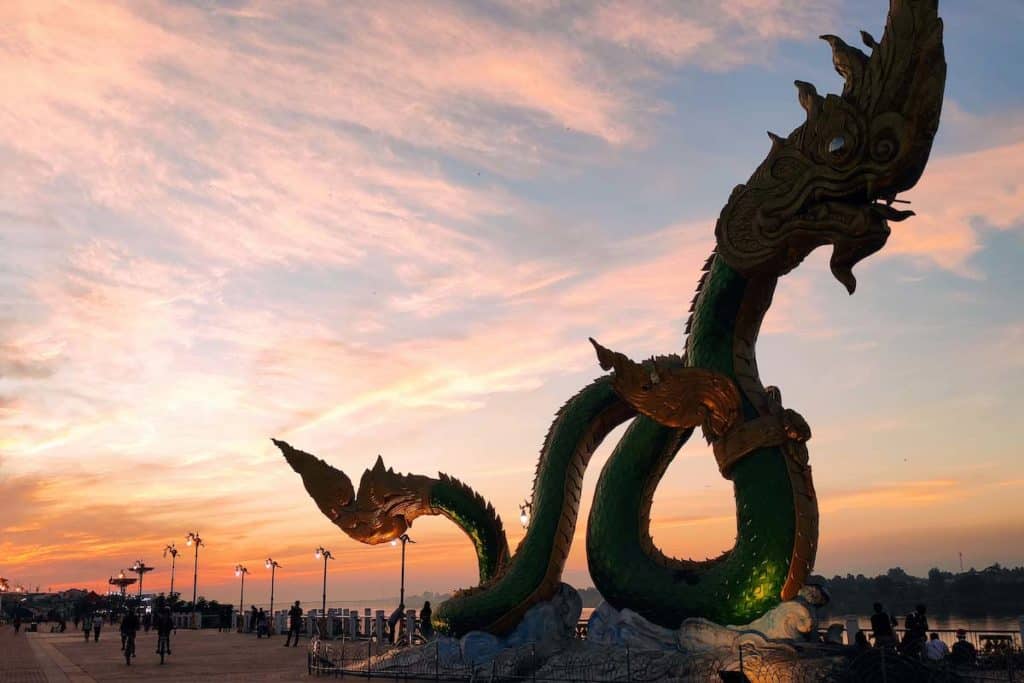
There are many other places that are not caves but involved with the myth of the Naga. For example, Kham Chanot (คำชะโนด) is located in Ban Dung District, Udon Thani Province.
It is believed that the Kham Chanot is the sacred place where the Nagas live and Wat Pa Klong 11 (วัดป่าคลอง 11) is located in Nong Suea District, Pathum Thani Province. It is believed that the Naga protect this temple.
There are also other important temples with a strong faith in Naga such as Naga Park or Buddha Park Luang Pu Sot Wang Phayanak 4 clans (พุทธอุทยานหลวงปู่สด วังพญานาค 4 ตระกูล) Prachinburi Province, Wat Roi Phra Putthabat Phu Manorom (วัดรอยพระพุทธบาทภูมโนรมย์) in the area of the Mukdahan National Park in Mukdahan Province, Wat Tham Pha Daen (วัดถ้ำผาแด่น) in Sakon Nakhon Province, Wat Phra That Nong Bua (วัดพระธาตุหนองบัว) in Ubon Ratchathani Province, and Wat Phu Taphao Thong (วัดภูตะเภาทอง) in Udon Thani Province, and so forth.
In addition, many statues of Nagas are built-in important places in Thailand, especially in the Northeast. This is the significant symbol representing the interaction between local people and beliefs or supernatural power that eventually assimilated and formed the precious culture, as it can be seen today.
Conclusion
Thailand’s Naka Cave is also one of the most attractive landmarks where you can get in touch with nature and learn about the local culture at the same time! If you are passionate about mythical stories and interested in venturing to the Northeast of Thailand, visiting the Naka Cave should be on the top of your list. Rest assured that you will have a truly remarkable experience when you visit here!
Like always, if you want to discover more about Thailand, stay guided with ThaiGuider. You might learn something you never knew about this unique country.
References
- Phan Anh Tu. The Signification of Naga in Thai Architectural And Sculptural Ornaments. [online] http://citeseerx.ist.psu.edu/viewdoc/download?doi=10.1.1.544.4626&rep=rep1&type=pdf
- Arunee Sriruksa and Kittisan Sriruksa. From the Myths and the Beliefs on Naga of the Isaan People to Cultural Tourism: A Case Study in Nongkhai Province Thailand. International Journal of Innovation, Creativity and Change Volume 15, Issue 8, 2021.
- สำนักอุทยานแห่งชาติ กรมอุทยานแห่งชาติ สัตว์ป่า และพันธุ์พืช. อุทยานแห่งชาติภูลังกา. [ออนไลน์] http://park.dnp.go.th/visitor/nationparkshow.php?PTA_CODE=9133
- คมชัดลึกออนไลน์. เปิดเหตุผล คนทะลัก “ถ้ำนาคา” แห่กราบไหว้ เศียรพญานาค เชื่อเสริมบารมี โชคลาภ [ออนไลน์] https://www.komchadluek.net/kom-lifestyle/504375
- สำนักอุทยานแห่งชาติ กรมอุทยานแห่งชาติ สัตว์ป่า และพันธุ์พืช. ถ้ำนาคา – อุทยานแห่งชาติภูลังกา. [ออนไลน์] http://portal.dnp.go.th/Content/nationalpark?contentId=26481
- สำนักอุทยานแห่งชาติ กรมอุทยานแห่งชาติ สัตว์ป่า และพันธุ์พืช. ถ้ำนาคี (Nakee Cave) – อุทยานแห่งชาติภูลังกา (เปิดบางแหล่ง). [ออนไลน์] http://park.dnp.go.th/visitor/scenicshow.php?id=1737
- จังหวัดนครพนม. ถ้ำนาคี อุทยานแห่งชาติภูลังกา อำเภอบ้านแพง จังหวัดนครพนม. [ออนไลน์] http://www2.nakhonphanom.go.th/travel/detail/48/data.html
- AllTrails. Nakee Cave – Phu Langka Peak. [online] https://www.alltrails.com/trail/thailand/nakhon-phanom/nakee-cave-phu-langka-peak
- Unseen Tour Thailand. ถ้ำกินรีนาคา [ออนไลน์] https://www.facebook.com/UnseenThailand/posts/3745148678830850/
- Sanook. “หินโลมา” โลเคชันสุดน่ารักที่ซ่อนอยู่ในน้ำตกกินรี จังหวัดบึงกาฬ. [ออนไลน์] https://www.sanook.com/travel/1423087/
- ไทยรัฐออนไลน์. 5 ข้อควรรู้ก่อนเที่ยวสายมูที่ถ้ำนาคา. [ออนไลน์] https://www.thairath.co.th/lifestyle/travel/2310801
- Richard Davis. Muang metaphysics: A study of Northern Thai Myth and Ritual (Studies in Thai anthropology). Bangkok: Pandora, 1984.
- Mayoury and Pheuiphanh Ngaosrivathana. The Enduring Sacred Landscape of the Naga. Chiang Mai: Mekong Press, 2009.
- สัตว์ในวรรณคดี. กินรี. [ออนไลน์] https://pratinsiri.wordpress.com/ข้อมูลของสัตว์แต่ละชนิ/กินรี/
- Eric Cohen. Chapter 4” The “Post modernization” of a Mythical Event: Naga Fireballs on the Mekong River in Tourism Culture & Communication (October, 2007): 85 – 104.
- New18. เปิดตำนาน “ถ้ำนาคี” ดินแดนศักดิ์สิทธิ์สุดลี้ลับ. [ออนไลน์] www.dnp.go.th
- เดลินิวส์ 7 ตำนานลี้ลับ มหัศจรรย์แห่ง “ภูลังกา.” [ออนไลน์] https://www.dailynews.co.th/news/488340/
- Natural History Museum. What is the biggest snake in the world? [online] https://www.nhm.ac.uk/discover/what-is-the-biggest-snake-in-the-world.html/.
- Mitrearth. หินนาคา ภูลังกา กับธรณีวิทยาน่ารู้. [ออนไลน์] http://www.mitrearth.org/17-8-nanga-cave/
- สำนักอุทยานแห่งชาติ กรมอุทยานแห่งชาติ สัตว์ป่า และพันธุ์พืช. อุทยานแห่งชาติภูหินร่องกล้า. [ออนไลน์] http://park.dnp.go.th/visitor/nationparkshow.php?PTA_CODE=1048
- Amazing Thailand. อุทยานแห่งชาติภูหินร่องกล้า. [ออนไลน์] https://thai.tourismthailand.org/Attraction/อุทยานแห่งชาติภูหินร่องกล้า
- Thailand Tourism Directory. ภูสิงห์ (หินสามวาฬ). [ออนไลน์] https://thailandtourismdirectory.go.th/th/attraction/832
- True ID. พิกัด ตามรอย พญานาค 18 สถานที่ เปิดตำนาน เมืองบาดาล อันศักดิ์สิทธิ์ [ออนไลน์] https://travel.trueid.net/detail/9wGZoZ2BDQ3q
- Sanook. 12 จุดเช็กอินตามรอยพญานาคทั่วเมืองไทย [ออนไลน์] https://www.sanook.com/travel/1422873/
- ไปด้วยกัน. 8 ถ้ำสวย ศักดิ์สิทธิ์ ตามรอยตำนานพญานาค [ออนไลน์] https://www.paiduaykan.com/travel/ถ้ำพญานาค
- สำนักอุทยานแห่งชาติ กรมอุทยานแห่งชาติ สัตว์ป่า และพันธุ์พืช. ถ้ำพญานาคราช (Phayanakarat Cave ) – อุทยานแห่งชาติภูผาม่าน [ออนไลน์] http://park.dnp.go.th/visitor/scenicshow.php?id=445
THINKING ABOUT A TRIP TO THAILAND?
I am working on a FREE Thailand Travel Guide with a FULL 7 Day Itinerary. Be the first to receive it!
Thank you for signing up.
Something went wrong.
